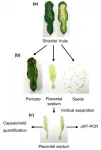An epic walk: 15 million years needed for dinosaurs to get from South America to Greenland
2021-03-09
(Press-News.org) For the first time, two researchers--one from the University of Copenhagen and the other from Columbia University--have accurately dated the arrival of the first herbivorous dinosaurs in East Greenland. Their results demonstrate that it took the dinosaurs 15 million years to migrate from the southern hemisphere, as a consequence of being slowed down by extreme climatic conditions. Their long walk was only possible because as CO2 levels dropped suddenly, the Earth's climate became less extreme.
A snail could have crawled its way faster. 10,000 km over 15 million years--that's how long it took the first herbivorous dinosaurs to make their way from Brazil and Argentina all the way to East Greenland. This, according to a new study by Professor Lars Clemmensen of the University of Copenhagen's Department of Geosciences and Natural Resource Management and researcher Dennis Kent of New York's Columbia University.
The herbivorous dinosaurs first appeared in Brazil and Argentina roughly 230 million years ago. This was during the early part of the Late Triassic period, the Norian, when the world consisted of one supercontinent called Pangæa, without any seas in between. The supercontinent allowed dinosaurs to disperse, unhindered from south to north. So, what took them so long to get to Greenland?
Professor Lars Clemmensen from University of Copenhagen and Nils Natorp from Geocenter Møns Klint on expedition in Greenland
The answer lies in unique rock deposits consisting of a 350-meter-long unbroken layer series of fossil sediments with bones from about 10 herbivorous dinosaurs that the researchers found on expeditions in East Greenland, and for which Lars Clemmensen and Dennis Kent have now made an accurate dating of.
Drastic fall in atmospheric CO2 levels
Using studies of these ancient sedimentary deposits to help them, the two researchers were able to see that the herbivorous dinosaurs reached East Greenland exactly 214 million years ago. Interestingly, their timing coincides with a major climatic shift that most probably helped them move along. The event? A drastic decrease in atmospheric CO2 levels 215 million years ago.
-"We are able to see that during the period leading up to the dinosaurs' migration, there was ten times as much CO2 in the atmosphere than there is today. This made it difficult for them to disperse from their original habitat in the southern hemisphere, as higher levels of CO2 produce more extreme climatic conditions. The desert areas they needed to traverse were excruciatingly hot and dry and the humid equatorial areas were tremendously unstable and wet. As such, climate was most likely a barrier that delayed the dinosaurs' northbound dispersion," explains Professor Lars Clemmensen from the Department of Geosciences and Natural Resource Management.
The dating was performed using magnetostratigraphic studies. Here, the researchers read the Earth's ancient magnetic fields in ancient lake deposits and compare them to similar, well-dated sedimentary sea deposits from elsewhere in the world. Even on a global scale, the researchers' access to a 350-meter thick unbroken layered series of fossils which includes early herbivorous dinosaurs and other contemporaneous vertebrates is extraordinarily unique. The unbroken layer series has allowed them to accurately read changes in Earth's ancient magnetic fields and made dating the layers safe.
Carnivorous dinosaurs were 600,000 years faster
Herbivorous dinosaurs weren't alone in East Greenland, which at the time was at the same latitude as the northeastern United States. Therefore, the area had a humid temperate climate. Small carnivorous dinosaurs had also made their way there. According to the researcher duo, the fossil finds in East Greenland and elsewhere also demonstrate that carnivorous dinosaurs were better at overcoming extreme climate barriers and migrating to new lands compared to their herbivorous relatives. The researchers' preliminary analyses show that the meat eaters reached East Greenland 600,000 years before herbivorous dinosaurs.
Lars Clemmensen, along with Danish, European and American researchers, has been on seven expeditions. Along the way, he has taken part in the work of discovering bones not only from herbivorous dinosaurs, but from carnivorous dinosaurs, flying lizards, labyrinthodontia and early mammals. The new dating method makes it possible to precisely determine their ages:
"With this new and very precise chronology, we have a tool to better understand the dispersal pattern of many early vertebrates on Pangæa. This holds especially true in the area between Northern Europe and East Greenland. We can go into every layer of soil where we have found bones and precisely determine their age," says Lars Clemmensen.
The research results are published in PNAS.
INFORMATION:
ELSE PRESS RELEASES FROM THIS DATE:
2021-03-09
Chili peppers (Capsicum spp.) are an important spice and vegetable that supports food culture around the world, whose intensity of its pungent taste is determined by the content of capsicumoids. However, the content of capsicumoids varies depending on the variety and is known to fluctuate greatly depending on the cultivation environment. This can be a big problem in the production, processing and distribution of peppers where sweet varieties can be spicy and highly spicy varieties are just only mildly spicy. It is thought that changes in the expression of multiple genes involved in capsaicinoid biosynthesis are involved in such changes in pungent taste ...
2021-03-09
When something bad happens to a child, the public and policy response is swift and forceful.
How could this have happened?
What went wrong?
What do we do to make sure it never happens again?
When a family becomes erroneously or unnecessarily enmeshed in the child welfare system, that burden is largely invisible - a burden borne mostly by the family itself.
In both situations, the fault for the systemic failure is often placed on the caseworker - overburdened, under-resourced, and forced to make quick and critical judgments about the risk ...
2021-03-09
In a new paper published in Light Science & Application, the group led by Professor Andrea Fratalocchi from Primalight Laboratory of the Computer, Electrical and Mathematical Sciences and Engineering (CEMSE) Division, King Abdullah University of Science and Technology (KAUST), Saudi Arabia, introduced a new patented, scalable flat-optics technology manufactured with inexpensive semiconductors.
The KAUST-designed technology leverages on a previously unrecognized aspect of optical nanoresonators, which are demonstrated to possess a physical layer that is completely equivalent to a feed-forward deep neural network.
"What we have achieved," explains Fratalocchi, "is a ...
2021-03-09
Obtaining a precise understanding of magnetic structures is one of the main objectives of solid-state physics. Significant research is currently being undertaken in this field, the aim being to develop future data processing applications that use tiny magnetic structures as information carriers. Physicists at Johannes Gutenberg University Mainz (JGU) and the Helmholtz Institute Mainz (HIM) recently presented a new method for investigating magnetic structures combining two different techniques. This allows to measure and map the magnetization as well as the magnetic ...
2021-03-09
For ice, so-called "surface melting" was postulated as early as the 19th century by Michael Faraday: Already below the actual melting point, i.e. 0 °C, a thin liquid film forms on the free surface because oft he interface between ice and air. Scientists led by Markus Mezger, group leader at the Max Planck Institute for Polymer Research (department of Hans-Jürgen Butt) and professor at the University of Vienna, have now studied this phenomenon in more detail at interfaces between ice and clay minerals.
In nature, this effect is particularly interesting in permafrost soils - i.e. soils that are permanently frozen. About a quarter of the land area ...
2021-03-09
The efficient provision of medical care is integral to society. Over time, the healthcare industry has tapped into modern technology in order to keep up its quality of service. This has, unsurprisingly, led to huge volumes of patient data. But it's not just patients whose data need to be stored; doctors, physicians, clinical staff, and even smart wearable gadgets are contributing to what is coming to be known as "healthcare big data."
Big data analytics (BDA), which involves the use of special design architectures to manage, store, and analyze complex data, is an important tool in healthcare. But it is hard to implement, owing to its high failure rate, resource-intensive process, and--most importantly--a lack of a clear guideline to aid practitioners. ...
2021-03-09
Light microscopes have revolutionized our understanding of the microcosmos, but their resolution is limited to about 100 nanometers. To see how molecules bond, break, or change their structure, we need at least 1000 times better resolution.
Laser induced electron diffraction (LIED) is a technique which allows to pinpoint the individual atoms inside a single molecule, and to see where each atom moves when the molecule undergoes a reaction. This technique proved to be an amazing tool for the imaging molecules, such as water, carbonyl sulfide or carbon disulfide. However, using a strong laser field to generate the electron diffraction presented challenges in retrieving the exact structure, since the structural resolution depended on exact knowledge of the ...
2021-03-09
New Haven, Conn. -- Mailing a package of SARS-CoV-2 tests to every household in America and asking people to use them once a week could greatly reduce total infections and mortality at a justifiable cost, a new study led by the Yale School of Public Health finds.
The research, published today in Annals of Internal Medicine, considers rapid antigen tests that warn people, in real-time, that they are potentially contagious and that they should isolate themselves before unknowingly spreading the disease to others. Investigators, led by Professor A. David Paltiel, assembled data on the epidemiology of SARS-CoV-2 and the natural history of COVID-19. They then used a mathematical model to estimate how many infections, hospitalizations, and deaths could be averted - and at what cost - by providing ...
2021-03-09
As much as a year's worth of past academic progress made by disadvantaged children in the Global South may have been wiped out by school closures during the COVID-19 pandemic, researchers have calculated.
The research, by academics from the University of Cambridge and RTI International, attempts to quantify the scale of learning loss that children from poor and marginalised communities in the Global South may have experienced, and the extent to which home support and access to learning resources could ameliorate it. While it is known that the education of these children has suffered disproportionately during the pandemic, it is much harder to measure exactly how much their academic progress has ...
2021-03-09
Women with polycystic ovary syndrome (PCOS) are at a significantly increased risk of contracting COVID-19 than women without the condition, new research led by the University of Birmingham has revealed.
Researchers are now calling for healthcare policy to specifically encourage women with PCOS to adhere to COVID-19 infection control measures while the global pandemic continues.
Polycystic ovary syndrome (PCOS) is a common condition affecting around one in 10 women in the UK. The three main symptoms are irregular periods, high levels of "male" hormones which may cause physical signs such as excess facial or body hair, and a cystic appearance on an ultrasound or MRI scan of the ovaries which is caused by follicles becoming increasingly fluid filled as they fail to develop and ...
LAST 30 PRESS RELEASES:
[Press-News.org] An epic walk: 15 million years needed for dinosaurs to get from South America to Greenland




